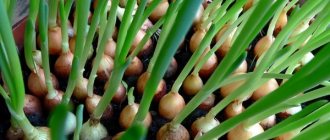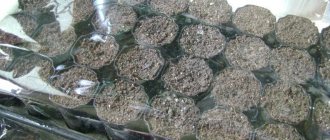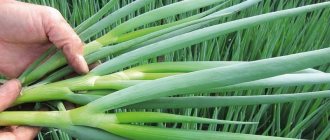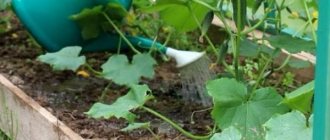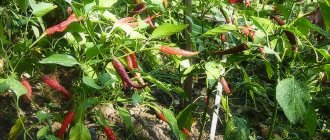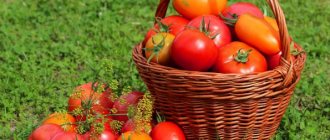Author's rating
Author of the article
Yakov Pavlovich
Professor, Head of the Department of Vegetable Growing
Articles written
153
Growing and caring for cucumbers in open ground is not an easy task. This capricious plant, originally from India, has high maintenance requirements. And without knowing the secrets of growing, you will not be able to get a healthy and rich harvest of cucumbers. Compliance with the rules of agricultural technology and planting technologies, timely elimination of diseases and pests will accelerate the onset of fruiting and extend its period to 3 months.
Varieties and hybrids suitable for growing in open beds
Planting short-fruited cucumbers in open beds is beneficial. When lying on the ground or tops, these varieties retain their shape and color better than others. They also require a minimum of attention and care.
The following varieties of cucumbers are popular.
Pasadena. Low bushes with a minimum volume of tops. Cucumbers are finely lumpy, without bitterness. The length of the gherkin is 7–10 cm. The first harvest is harvested 50–55 days after germination.
Pasamonte F1 . One of the early varieties. The bushes are formed into 2 stems. Cucumbers are 5–8 cm long with large tubercles. The harvest is harvested 40–45 days after planting the seeds in open ground.
Alekseich F1. Medium-sized self-pollinating hybrid of early maturation. The length of the cucumber is 7–8 cm. The skin is lumpy, emerald in color.
Bear. The ripening period is 45 days from sowing in the ground. The cucumber has a pleasant taste with a crispy skin. The mass of the specimen is 55–70 g. Length is 8 cm.
Among other early varieties, the most popular are Malysh, which produces a crop already on the 35th day after the first shoots, the cold-resistant and disease-resistant variety Izyashchny, the bush cucumber Malyshok, weighing 90 g, and the Altai variety, which bears fruit on the 37th day. These are not the only varieties grown in open ground. Each gardener has his own favorite variety, thoroughly studied and cultivated annually.
Site selection and soil preparation
To grow cucumbers, you should choose a sunny area with access to light, protected from drafts and cold winds. When planting, it is imperative to observe crop rotation; you can plant a plant in one place once every 4 years. It is best to place this vegetable crop after peppers, tomatoes, cabbage, onions or garlic.
The optimal soil for growing is neutral or slightly acidic pH 5-7. An alkaline environment is not suitable for planting, as it affects the yield.
Before growing, you need to prepare the bed in advance in the autumn:
- dig up the soil;
- add compost, humus or manure and additional potassium and superphosphate;
- Instead of organic fertilizer, also use mineral fertilizer: ammonium nitrate and urea.
You can build a warm bed on the site; to do this, you need to make a platform about 1 m wide from rotted parts of plants and soil, and lay hay on the sides. When the height is 20 cm, you can proceed to forming the side; mullein is perfect for this. The edge of the structure must be raised by 60 cm, and fertile soil or humus must be added to the middle. Next, cover the structure with film and wait 3-4 days. If straw was used, it must first be poured with boiling water and then covered.
How to plant cucumbers in open ground correctly
It is not difficult for a gardener to grow cucumbers in open ground if he has at least the slightest knowledge of agricultural technology and the rules for caring for garden crops.
Sowing methods
You can plant cucumbers in open ground using seeds or seedlings that are previously grown at home. The choice of method depends on the preference of the gardener and the growing region. The seed method is more suitable for the southern regions, where the earth warms up earlier.
Before planting seeds for seedlings or directly into the ground, treatment is carried out.
Seed preparation:
- Selection. Prepare a saline solution at the rate of 3 tbsp. l. per liter of water into which the seed is placed. Healthy specimens will fall to the bottom. The floating seeds are removed.
- Warming up. Selected cucumber seeds are kept near the battery for a month. Or heat in the oven at 50 °C. The third option is to put the seeds in a thermos and fill them with water at a temperature of 45–50 °C, where they are kept for half an hour. Warming up will speed up germination and reduce the volume of barren flowers.
- Disinfection. This disinfection procedure is in a solution of potassium permanganate or iodine, or pureed garlic. Carried out to prevent infections.
- Stratification. The seeds are kept in the refrigerator for 24–36 hours.
- Soak. The seeds are placed on gauze moistened with a biostimulant. The temperature is maintained at 28–30 °C and the gauze is constantly moist. The procedure time ends when the cucumber seeds hatch 3–5 cm.
Expert opinion
Stanislav Pavlovich
Gardener with 17 years of experience and our expert
Ask a Question
Attention. Seeds of hybrid varieties of cucumbers are not heated before planting.
Seedlings
The prepared seeds are planted in a seedling box. The soil is prepared from humus, turf, sawdust. Expanded clay (drainage) is placed at the bottom of the box. The container is covered with film or glass. Next, the standard procedure for growing seedlings indoors is carried out.
See also How to spray cucumbers with soda
When sprouts appear, the glass is removed, weak sprouts are removed, and soon the shoots are dived into separate cups. From these, seedlings are transplanted into the ground. If the cups are peat, the seedlings are transferred to the ground along with them.
Important. Seedlings begin to grow 30 days before transferring to the ground. The procedure will speed up the production of early cucumbers.
Seeds
When planting by seed, seeds that have undergone processing are planted directly into the ground according to the scheme.
To what depth
Before sowing, special soil is prepared containing a large amount of vitamins and minerals. Mix nutritious garden soil with humus or compost in equal volumes. The ingredients are taken in equal volumes. Wood ash is added if desired.
Before planting, the soil temperature is checked, which should be at least 15 °C. Otherwise, the earth warms up.
Organization of growing cucumbers
There are a large number of varieties of cucumbers, differing in size, shape, taste, etc. Like other crops, cucumbers are divided according to their ripening speed into:
- early ripening (35-45 days from emergence to harvest);
- early (45-60 days);
- mid-season (up to 56 days);
- late 56+ days.
In greenhouses, these periods can be reduced by 8-15 days. Growing cucumbers is a rather complex and painstaking process; the plant should be constantly monitored and the necessary recommendations must be strictly adhered to.
Cucumbers in open ground on supports in the form of arches
To understand how to care for cucumbers, you need to understand the peculiarities of growing this crop. There are several rules for cucumbers, the violation of which not only leads to a decrease in yield, but can also destroy the crop:
- Cucumber is a heat-loving plant. It should be planted in beds at temperatures not lower than +13°C and in the absence of the likelihood of reverse frosts. The best growth of the crop after sowing is observed at air temperatures from 24°C to 28°C
- Good nutrition is the key to a bountiful harvest. Cucumbers should be planted in pre-prepared soil and fed during cultivation.
- Since the root system of the cucumber is near-soil (most of the roots are located no deeper than 5 cm), loosening the soil is prohibited. For normal soil breathability, light soils and the correct predecessor should be used.
- Cucumbers require a lot of moisture. The optimal soil moisture level is 80%. When this parameter is less than 30%, the crop wilts. Taking into account the heat-loving nature of cucumbers, watering should not be done at temperatures below +18°C
- This plant is considered a short-day garden crop. Therefore, the optimal time for growing it is not only the beginning, but also the end of summer. For normal growth, the plant needs 10-12 hours of light. This means that you can grow cucumbers not only in sunny areas, but also in partial shade.
There are several schemes for growing cucumbers, sometimes radically different from each other, but the listed points are observed in any case, otherwise the crop will grow and bear fruit at a low rate. Next, various methods of growing cucumbers will be considered and tips on caring for the crop will be given.
Disembarkation process
There are two ways to grow cucumbers from seeds. In the horizontal version, the grown lashes spread along the ground. The vertical method requires trellises along which the plant's branches are woven.
First planting technology:
- Two rows of holes are prepared. The distance between them is 35–40 cm, between the rows – 50 cm. 75–80 cm are left for passage.
- Each hole is filled with fertilizer. This is compost or humus mixed with soil with the addition of ½ cup of ash. Cover the top with earth.
- The seeds are buried 2 cm in the holes and planted at an angle of 45° with the sharp tip up. Place 2-3 seeds in a hole.
- The soil is moistened, the plantings are covered with a film with holes for future shoots.
- The film is removed during the day and returned to its original positions in the evening. The procedure is carried out until the shoots grow.
In the second case, 20–30 cm are left between the holes, and the same between the rows. 3-4 seeds are placed in each hole. The seedlings are thinned out with scissors. Professionals believe that with this method of growing cucumbers in open ground, the yield is higher.
The seedlings are transplanted into an open area in the same way as the seeds. If the seedlings are in peat cups, no fertilizing is carried out.
In the first days after planting, the soil is well moistened and protected from direct sunlight and wind.
Where to start caring for cucumbers
Caring begins with determining the landing site. Our family has its own secret - to surround the cucumbers with corn around the perimeter. It grows first and protects later cucumbers well from the scorching sun, strong winds and drafts. And if you consider that cucumber is a heat-loving and moisture-loving crop, then such a protective barrier is just what it needs. It’s not for nothing that they say that “corn is the nanny of cucumbers.”
Cucumber gets along with almost all vegetable crops, except radishes, tomatoes and potatoes. Grows well next to beans, peas, cauliflower and white cabbage, lettuce and celery. Even weeds such as quinoa and tansy can be useful neighbors. They release substances into the air that are harmful to fungal diseases.
Watering rules
Cucumbers need frequent watering. But it is worth paying attention to some nuances. Watering is carried out in accordance with weather conditions. On rainy days, avoid watering due to the possibility of brown rot. When the air temperature is below 15 °C, the seedlings are not watered. In these cases, in the country house and garden, the soil is loosened between the rows.
Rain water is better for irrigation. It contains a lot of oxygen and useful elements. Water is used at room temperature. With colder watering, plants slow down, the number of ovaries decreases, and even those fall off. After 19 hours, watering is not recommended.
Attention. Do not water cucumbers with cold water. The soil cools, and at the same time the absorption of liquid worsens. The water temperature for irrigation is not lower than 17–18 °C.
Pinching and shaping the bush
Pinching is one of the most important agricultural techniques in obtaining a rich harvest. Stepchildren constantly growing in the axils of the leaves take a lot of energy from the plant to maintain them, which naturally occurs to the detriment of fruit set. In addition, experts say that if the growth of cucumber vines is not controlled, then many male flowers - barren flowers - will form on them. You cannot get fruit from them. To form a harvest, it is necessary to create the best possible conditions for the appearance of female flowers that grow on the lateral vines of plants.
How pinching helps:
- female flowers are formed en masse;
- the fruits become sweet (the bitterness disappears);
- the harvest is increasing.
In varietal cucumbers, all growth points located above 4-5 leaves are pinched. This causes the formation of branches of the second and third orders, on which female flowers are formed, and therefore the main harvest.
Hybrid plants usually grow in a single stem. In this case, all lower shoots, ovaries and inflorescences are plucked out to a height of half a meter. Then, in the interval from 0.5 meters to 1 meter, one leaf is left in the sinuses, then 2, and then 3.
Note!
In early varieties, female flowers are formed on the main stem, and therefore you should not pinch it.
Loosening the soil
Thanks to this procedure, soil ventilation will improve and oxygen will become more available to the roots. Based on the advice of experienced gardeners, loosening is indicated when a crust appears on the ground. It is carried out carefully so as not to touch nearby roots. It is enough to go deeper by 3–4 cm. Peat soil is more difficult to loosen. Good performance is achieved when using a pitchfork.
Stage 2 – preparing the container and soil for seedlings
You can plant seeds in disposable paper cups, having previously made drainage holes in them, or you can make cups from plastic film removed from the greenhouse or old, but thick bags.
I used a jar as a blank, and it can be of any volume - it all depends on what size glasses you need. After wrapping the jar in overlapping polyethylene, secure the free edge with tape in two places. Then fold the bottom edge of the polyethylene, fold it and also secure it with tape.
When transplanting a seedling into the ground, such a glass can simply be unrolled without harming the roots, and this is very important, because root trauma can be disastrous for the cucumber: it will hurt for a long time, and its adaptation in the ground will take one and a half to two weeks.
If you make glasses from a plastic sleeve, cutting it into pieces, you will have to fit some kind of stand under them so that the roots of the seedlings do not cling to anything and do not break off.
I make the soil for seedlings from equal parts of humus and garden soil, but instead of soil, you can add husks to the humus. The main thing is that the substrate is loose and fertile.
Feeding with fertilizers
Even if fertilizing was carried out when planting cucumbers in the soil, fertilizers are applied 3–4 times during the growing season. Moreover, these are root and foliar feedings.
Expert opinion
Stanislav Pavlovich
A gardener with 17 years of experience and our expert. See also: Cucumbers grow poorly and die: how to revive cucumbers in the garden
Ask a Question
Important. Foliar feeding is more suitable for cool weather. Under these conditions, cucumbers will receive nutrients through the foliage, which is much faster than from the soil.
Compositions for fertilizing:
- A week after planting the crop in the ground. For a bucket of water - 1 tbsp. a spoonful of mullein or urea. Per bush - half a liter of composition.
- After 8–10 days. Dilute 15 g of urea and potassium sulfate, 5 g of superphosphate in 10 liters of water.
- During the flowering period the same composition. Treatment is carried out in the early morning or evening.
- From the beginning of fruiting until the harvest of cucumbers, potassium and nitrogen fertilizers are applied once every ten days.
- During flowering and fruiting, fertilizer made from green herbs is useful. Half of the large barrel is occupied by nettles, comfrey, and dandelion. Fill to the top with water, close and leave for 2 days, constantly stirring the composition. When watering, the fertilizer is diluted with water 1:10. Watering is carried out at the root. Shoots will grow faster, ovaries will form, and cucumbers will form.
Constant care will not ignore changes in the condition of the plant, indicating an excess or lack of nutrients.
Plant growth slows down, leaves fade, shoots become thinner, cucumbers become shorter. Conclusion: not enough nitrogen. Top dressing – mullein, urea.
The leaves have yellow spots, but the veins are still green. The growth and formation of cucumbers slows down - magnesium deficiency. Wood ash and potassium magnesia will save you.
Young leaves are small, old leaves have a yellow border, cucumbers have a bitter taste - lack of potassium. Treatment: wood ash, potassium sulfate, weak solution of potassium permanganate.
The growth of bushes and fruits slows down, the leaves become denser and become dark green. This is a lack of phosphorus, which is compensated by the addition of superphosphate and nitrophoska.
Harvesting
Depending on the selected variety or hybrid of cucumbers, the growing season of plants can range from 40 to 70 days. But in order for the ovaries to form more actively, it is necessary to regularly collect ripe fruits (at least once every 2-3 days). In this case, the greens do not outgrow, their presentation and taste do not deteriorate.
With regular, timely harvesting, the fruiting of cucumber bushes increases, and the vines themselves are less depleted.
Usually, ripe greens are harvested early in the morning, before the sun has time to heat the fruits.
Protection from diseases and pests
To protect against diseases, it is necessary to follow agrotechnical rules.
These include the following points:
- maintaining the schedule and volumes of fertilizer application;
- soil moisture control;
- correct watering mode, use of warm water;
- compliance with the sowing methods and plan.
Main diseases in open ground:
- anthracnose, cause – high humidity, treatment – Bordeaux mixture;
- powdery mildew, cause – causative fungus, treatment – mullein, Bordeaux mixture, whey;
- root rot, cause – soil infection, treatment – “Fitosporin-M”, “Hom”, “Baktofit”.
Among the pests are aphids that drink the juice of the crop. As a result, the leaves curl and fall off. Particularly popular are soap-ash compositions, which are used to wash the leaves against the pest. Processing is carried out in the morning. During the day, the plant is protected from burns. Repeat the procedure after 5 days.
Techniques for increasing cucumber yield
In addition to the basic technological techniques, there are other manipulations that lead to an increase in the yield of cucumbers.
Among them are the following techniques:
- Stop watering before flowering. Reception provokes rapid formation of fruits.
- Planting mixed varieties and hybrids in one area. This improves crop pollination.
- Ringing of stems impedes the flow of nutrition to the roots. All nutrients go towards increased formation of ovaries.
- Attracting bees to the site to enhance pollination. Bowls of honey or honey plants will do the trick.
- The yield of cucumbers will increase if cabbage, peas, and celery are planted nearby.
- Another option to increase the yield is to water with apple cider vinegar. The composition is prepared at the rate of: 1.5–2 cups of vinegar per 200 liters of water.
- Treatment during the flowering period with plant growth stimulants (Epin, Zircon).
And of course, supports that lift the branches. Air circulation will improve, which means fruiting will also improve.
When to plant cucumbers for greenhouse seedlings
When determining the optimal time for sowing and planting, one should proceed from the climatic characteristics of a particular region.
From sowing the seeds until the seedlings are ready for planting, it takes about 3-4 weeks. Seedlings are planted at a time when stable warmth without night frosts has already established. For example, in the south, sowing is carried out at the end of March, in the middle zone it is better to sow in the second ten days of April, in the Urals and Siberia - at the end of April - beginning of May.
Many gardeners practice the seedless method, planting cucumbers with seeds at a specified time directly in the greenhouse, which avoids damage to the very delicate root system of cucumber seedlings when transplanting to a permanent place.
When using purchased seeds, you need to take into account the manufacturers' recommendations - approximate dates and planting patterns are usually indicated on the back of the package
When planning sowing, some gardeners are guided by the lunar calendar, because they believe that the influence of the earth’s satellite is reflected in the growth and development of plants: the waning Moon is favorable for planting root crops, “roots,” while the growing Moon is favorable for those bearing fruit above the ground, that is, “tops.”
In 2022, the most suitable periods for sowing cucumbers for seedlings and planting them in a permanent place are the following periods:
| Month | Numbers |
| March | 3-8, 10-13, 15, 26, 30 |
| April | 3-7, 9-11, 13-14, 18, 25, 29 |
| May | 1-6, 8-14, 24, 28 |
| June | 1-5, 7-13, 23, 27, 30 |


